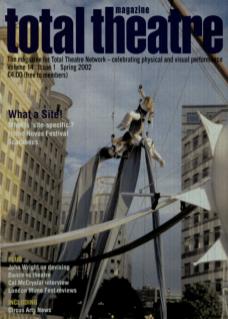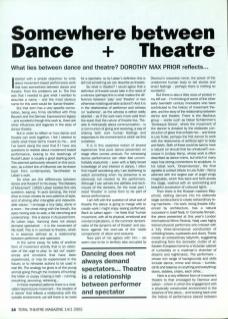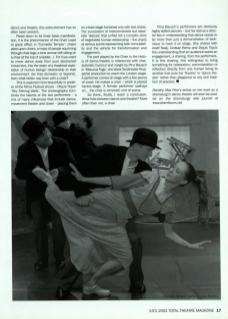I started with a simple objective: to write about movement-based performance work that lives somewhere between dance and theatre. Then the problems set in. The first was that I needed to give what I wanted to describe a name – and the most obvious name for this work would be 'dance-theatre'.
But that term has a very specific connotation, being very firmly identified with Pina Bausch and the German Expressionist legacy – and wonderful though this work is, there are other influences and legacies in the story of dance-theatre.
But in order to reflect on how dance and theatre can work together, I felt I needed to clarify what these terms meant to me... and I've learnt along the road that if I have any questions to resolve about movement-based performance, looking to the teachings of Rudolf Laban is usually a good starting point. This seemed particularly relevant on this occasion, as a direct line of influence can be drawn back from contemporary Tanztheater to Laban's work.
So what are the differences between dance and theatre? In his essay 'The Mastery of Movement' (1950) Laban tackles this very question, saying: 'In pure dancing, the inner drive to move creates its own patterns of style, and of striving after intangible and indescribable values.' I envisage a tiny baby, alone in a room – the chest rising with the breath, the eyes moving side-to-side, a fist clenching and unclenching – this is dance in its purest form. As Laban says, 'dancing does not always demand spectators' – it is the movement of life itself. This is in contrast to theatre, which is in essence defined as a relationship between performer and spectator.
Dancing does not always demand spectators... Theatre is a relationship between performer and spectator.
In the same essay he talks of another form of movement activity that is an extension of the urge to play: to 'act out' experiences and emotions that have been experienced, or may be experienced in the future; or to rehearse actions to be used in real life. The analogy he gives is of the young animal going through the motions of hunting – the kitten or puppy chasing a ball – running, crouching, pouncing, retrieving...
In these repeated patterns there is a motivation beyond pure movement – the creation of a 'dance’ that reflects a relationship with the outside environment; yet still there is no need for a spectator, so by Laban's definition this is still not something we can describe as theatre.
So what is theatre? I would agree that a definition of theatre would take in the need of a witness (perhaps this is what makes the difference between 'play' and 'theatre' in two otherwise indistinguishable actions?). And it is in the relationship of performer and witness (or 'audience', as the witness is rather oddly labelled – as if the ears were more valid than the eyes) that the nature of theatre lies. Theatre is intrinsically about communication – is a communion of giving and receiving, a way of sharing both core human feelings and responses to the environment in which we find ourselves.
It is in this essential notion of shared experience that pure dance presented on stage often comes unstuck. For witnessing dance performance can often feel uncomfortably voyeuristic - even with a fairly broad knowledge of and interest in dance, I often find myself wondering why I am bothering to watch something when my presence is so obviously not needed by the performers. Although I can admire the abilities and techniques of the dancers, for the most part need ‘theatre' in some form to be part of dance performance.
I am left with the question of what sort of theatre the dance is going to merge with to create work I might enjoy seeing performed. Back to Laban again – he feels that 'human movement, with all its physical, emotional and mental implications, is the common denominator of the dynamic art of theatre' and cautions against the overuse of the 'static components' of décor and costume.
Now part of me agrees with him – we seem now to be in territory also occupied by Decroux's corporeal mime: the power of the unadorned human body to tell stories and enact feelings – perhaps there is nothing so wonderful.
But there is also a little voice of protest in my left ear – I'm thinking of some of the other early twentieth century innovators who have contributed to the history of movement theatre, and the story of the relationship between dance and theatre. There is the Bauhaus group – works such as Oskar Schlemmer's Grotesque Dance, where the movement of the dancer is dictated by the elaborate construction of glass that enfolds her... and there is Lois Fuller, perhaps the first dancer to work with the relationship of artificial light to body and fabric. Both of these could be said to have a natural (or should that be unnatural?) successor in Lindsay Kemp, whose work is often described as dance-mime, but which in many ways has strong connections to sculpture. In his latest work, Dreamdances, the final vignette is a direct tribute to Lois Fuller – Kemp adorned with the largest pair of angel wings imaginable, which flow back and forth across the stage, washed with an astonishing and beautiful succession of coloured lights.
Then there is the Russian maestro Meyerhold, slotting dancers into his elaborate stage constructions to create extraordinary living machines – his work, being theatre influenced by architecture, has a natural successor in Josef Nadj. In Comedia Tempio the piece presented at this year's London International Mime Festival, Nadj uses highly trained physical performers who interact with a fully three-dimensional construction of unfolding boxes, cupboards and doors. These create an extraordinary labyrinth, suggesting everything from the domestic clutter of an Eastern European home to a Victorian cabinet of curiosities or a madman's chamber of dreams and nightmares. The performers – whose rich range of backgrounds and skills include dance, mime and circus – tumble, climb and balance on anything and everything – doors, ladders, chairs, each other...
Here is a very different form of movement theatre to that envisaged by Decroux and Laban – a form in which the engagement with a physically constructed environment is the essence of the piece... and looking back over the history of performance placed between dance and theatre, this extra element has so often been present.
Pared down to its most basic manifestation, it is the phenomenon of the Chair (used to great effect in Comedia Tempio: chairs piled upon chairs; a mass of people squirming through chair legs; a lone woman left sitting on a chair at the top of a ladder...). For if you want to move dance away from pure abstracted movement, into the realm of a theatrical exploration of human beings' relationship to their environment (be that domestic or beyond), then what better way than with a chair?
This is explored most beautifully in another of the Mime Festival shows – Diquis Tiquis’ Shy Shining Walls. The choreography combines the talents of the two performers – a mix of many influences that include dance, movement theatre and clown – placing them on a bare stage furnished only with two chairs. The succession of interconnected but separate 'dances' that unfold tell a complex story of negotiated human relationship – the chairs at various points representing both immutability and the vehicle for transformation and engagement.
The part played by the chair in the history of dance-theatre is referenced with characteristic humour and insight by Pina Bausch in Masurca Fogo, the latest lanztheater Wuppertal production to reach the London stage. A performer comes on stage with a few pieces of wood. He makes a chair – which is placed centre-stage. A female performer sashays on... the chair is removed: end of scene.
So there, finally, I reach a conclusion, What lives between dance and theatre? More often than not, a chair.
Pina Bausch's performers are obviously highly skilled dancers – but her skill as a director lies in understanding that dance needs to be more than just a demonstration of technique to hack it on stage. She shares with Josef Nadj, Lindsay Kemp and Diquis Tiquis the understanding that an audience seeks an engagement, a sharing, from the performers. It is this sharing, this willingness to bring something for celebration, commiseration or reflection directly from one human being to another that puts the ‘theatre' in 'dance theatre' rather than allegiance to any one tradition of practice.
Dorothy Max Prior's article on her work as a dramaturg in dance-theatre will soon be posted on the dramaturgy web journal at www.dramforum.net


